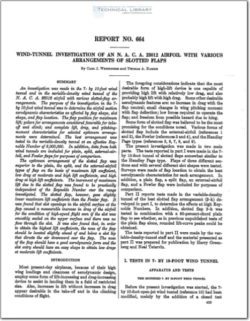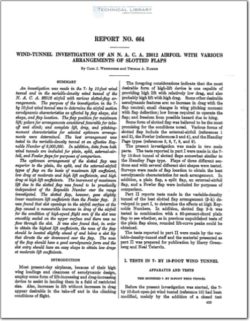NACA-REPORT-664

- Version
- 456 Downloads
- 2.06 MB File Size
- 1 File Count
- March 24, 2016 Create Date
- March 24, 2016 Last Updated
National Advisory Committee for Aeronautics, Report - Wind-Tunnel Investigation of an N.A.C.A. 23012 Airfoil with Various Arrangements of Slotted Flaps

An investigation was made in the 7— by 10-foot wind
tunnel and in the variable-density wind tunnel of the
N. A. C’. A. 23012 airfoil with various slotted-flap ar-
rangements. The purpose of the ineestigation in the 7'-
by 10-foot wind tunnel was to determine the airfoil section
aerodynamic characteristics as afeeted by flap shape, slot
shape, and flap location. The flap position for maximum
lift,- polars for arrangements considered favorable for take-
of and climb; and complete lift, drag, and pitching-
moment characteristics for selected optimum arrange-
ments were determined. The best arrangement was
tested in the variable-density tunnel at an efectice Reg-
nolds Number of 8,000,000. In addition, data from both
wind tunnels are included for plain, split, external-air-
foil, and Fowler flapsjor purposes of comparison.
The optimum arrangement of the slotted flap was
superior to the plain, the split, and the ertenwl—a/irjoil
types of flap on the basis of maximum lift eoefiicient,
low drag at moderate and high lift coeflicients, and high
drag at high lift coeficients. The increment of maximum
lift due to the slotted flap was found to be practically
independent of the Reynolds Number over the range
investigated. The slotted flap, however, gaoe slightly
lower maximum lift coeflicients than the Fowler flap.
It was found that slot openings in the airfoil surface at the
flap caused a measurable increase in drag of the airfoil
for the condition of high-speed flight even if the slot was
smoothly sealed on the upper surface and there was no
flow through the slot. It was also found that, in order
to obtain the highest lift coeficients, the nose of the flap
should be located slightly ahead of and below a slot lip
that directs the air downward ocer the flap. The nose
of the flap should have a good aerodynamic form and the
slot entry should have an easy shape to obtain low drags
at moderate lift coeficients.
| File | Action |
|---|---|
| NACA-Report-664 Wind-Tunnel Investigation of an N.A.C.A. 23012 Airfoil with Various Arrangements of Slotted Flaps.pdf | Download |
Comment On This Post